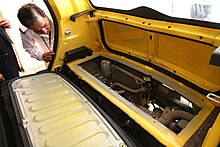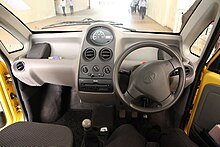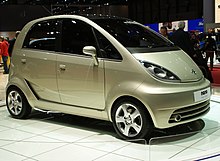Tata Nano
This was not achieved, and various factors led to a decline in sales volume, including delays during the factory relocation from Singur to Sanand, early instances of the Nano catching fire and the perception that the Nano was unsafe and lacked quality from its aggressive cost cutting.
[12] The purchase price of this no frills auto was brought down by dispensing with most nonessential features, reducing the amount of steel used in its construction, and relying on low cost Indian labour.
The design featured only a driver's side wing mirror, one wiper blade, only three lug nuts per wheel and a fuel tank without filler cap.
At introduction the Nano received attention due to its low price of 1 lakh rupees (Rs.
A 2008 study by Indian rating agency CRISIL projected the Nano would expand the nation's car market by 65%,[16] but, as of late 2012, news reports have detailed the underwhelming response of the Indian consumer to the offering; sales in the first two fiscal years after the car's unveiling remained steady at about 70,000 units.
Tata intended to maintain a capacity to produce the car in much larger quantities, some 250,000 per year, should the need arise.
[23] Announced as the most affordable production car in the world, Tata aimed for a price of one lakh rupees, or ₹100,000, which was approximately $2,000 US at the time.
[26] Compared to the Volkswagen Beetle it had a relatively low price, though still high in terms of the average salary of an Indian industrial worker or farmer.
0-100 km/h (62 mph): 30 seconds[4][31][32] In May 2015, to revive the model's sales, Tata Motors introduced a series of enhancements both inside and outside the car.
[37] Electric power steering, air conditioning, and Bluetooth radio were available on top models in addition to new colors and alloy wheels.
If an EV Nano had been produced the expectations were that it would have been a highly affordable electric car[44] using lithium-ion batteries and having a range of 80 miles (130 km).
[50] The company denied those were connected to the car's design or its parts and blamed "foreign electrical equipment" found on top of the exhaust system.
[50] Tata extended the warranty on the car, including those already sold, from 18 months to four years in early December 2010.
[50] The Nano received a mixed reception from Indian consumers; reasons given included that it was still too expensive compared to a motorcycle, and the extended waiting time for delivery (a few months).
Tata had made it public that a version of the Nano designed for export to Europe had passed R94, and they were also expecting a four star Euro NCAP result.
During the 64km/h NCAP test the passenger compartment not only became unstable but also showed extremely high levels of intrusion of the steering column and waist-level intrusion of the A-pillar, showing high risk of life-threatening injury to the driver's head, neck and chest and also indicating that less critical body regions like the knees, tibias and feet were unlikely to be recoverable.
[66] In 2023 and 2024, according to some recent sources from news all over the world, there is some rumors that Tata could revive the Nano as an affordable all-electric car with roughly 150-250km range at a future date, though it is unknown when would the new second generation is going to be revealed.





